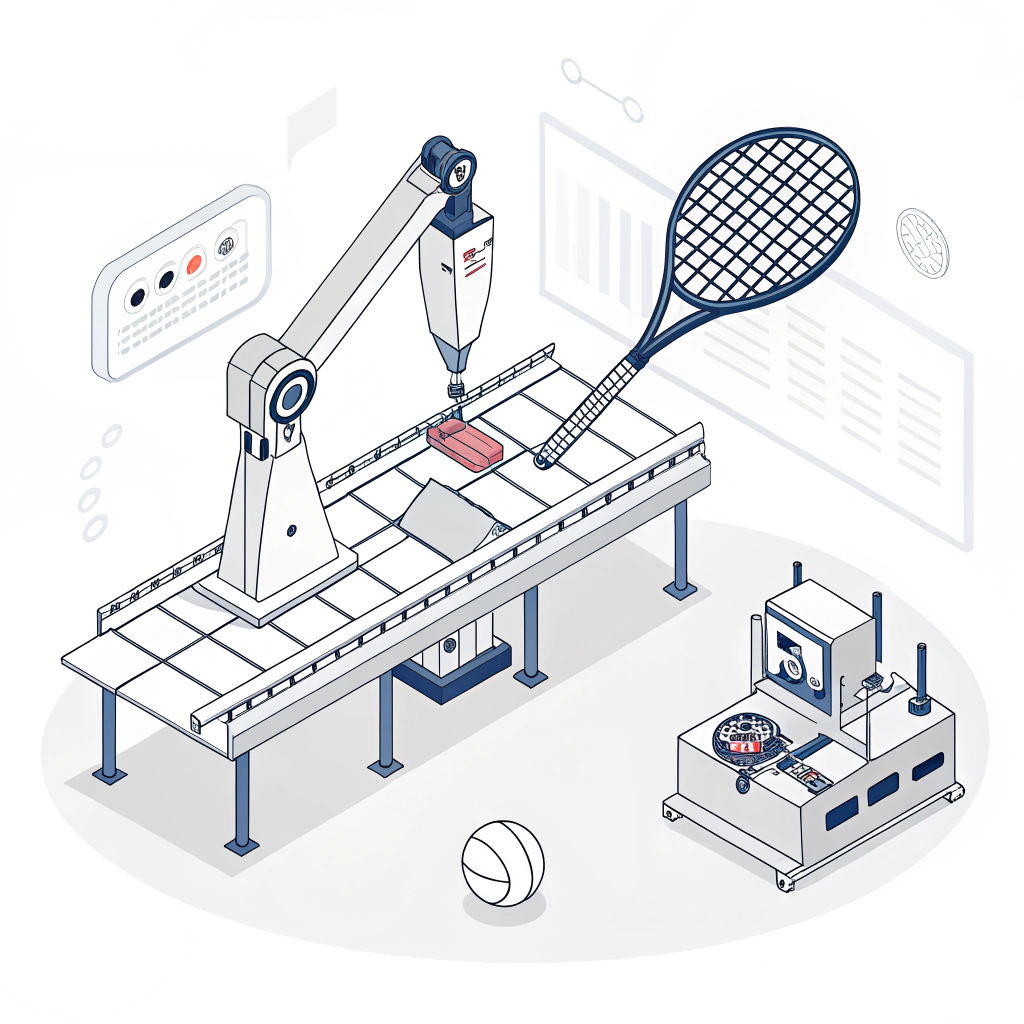Padel rackets have evolved from simple handcrafted models into technologically advanced sporting equipment that leverages state‐of‐the‐art materials and production techniques. In a nutshell, modern padel racket manufacturing combines precision engineering1, innovative carbon fiber2 applications, and customized processes to produce rackets that offer durability and peak performance.
In recent decades, the padel industry has witnessed a transition driven by stringent quality requirements and competitive market dynamics. Historically, padel rackets were manufactured with basic materials such as fiberglass, with limited customization and often inconsistent quality. However, as demand grew both from padel clubs and retailers, manufacturers began adopting advanced production methods that incorporate various grades of carbon fiber—notably 3K, 12K, and 18K types. These variants offer different levels of stiffness, durability, and overall performance, addressing the varied needs of both recreational and professional players.
The evolution in manufacturing is not only a tale of material innovation; it is also a story about process refinement. Today’s advanced production techniques in padel manufacturing ensure high precision in racket dimensions, shape, and weight distribution. With modern mold customization, manufacturers are able to produce rackets in different shapes—such as Diamond, Round, and Teardrop designs—and can tailor each product to suit the ergonomic and performance requirements of players.
-
Material Advancements:
The transition from fiberglass to carbon fiber has radically improved racket performance. The integration of different carbon types—3K for its balance of flexibility and strength, 12K for a reliable stiffness and resilience, and 18K for competitive rigidity—has allowed manufacturers to design rackets suited for various play styles. These materials not only reduce weight but also enhance durability over prolonged use. -
Precision Engineering:
Advanced automation and computer-aided design (CAD)3 have revolutionized the assembly lines in padel production. Precision in cutting and layering carbon fiber, conducting quality tests, and ensuring correct weight distribution has minimized manufacturing variances. This shift to precision engineering supports a consistent product performance benchmark that B2B buyers can rely on. -
Customization and Flexibility:
Today, manufacturers like NEX Padel offer extensive customization options. Not only can racket shapes be fully customized based on player needs, but the finishing touches—such as custom-printed logos and bespoke color combinations—as well as personalized hand grips and handle covers, enable brands to differentiate themselves in a saturated market.
A critical element of modern padel racket manufacturing is the standardized workflow that ensures quality while catering to market-specific demands. Below is a table summarizing the main differences between historical methods and modern production techniques:
| Aspect | Historical Methods | Modern Advanced Techniques |
|---|---|---|
| Materials Used | Primarily fiberglass; limited carbon fiber usage | Multiple carbon fiber types (3K, 12K, 18K); high-grade composites |
| Production Precision | Manual, variable quality control | Automated, computer-aided machining and molding, strict quality protocols |
| Customization Capabilities | Limited shapes and color variations | Fully customizable shapes (Diamond, Round, Teardrop) and printing options on grips and handles |
| Quality and Durability | Inconsistent; prone to defects | High precision engineering minimizes defects, ensuring durability and reliable performance |
| Lead Time | Longer production cycles | Optimized processes ensure quick sampling and timely delivery |
One of the key innovations in modern techniques is the use of advanced molding technology4. With the ability to control the placement of every shred of carbon fiber, manufacturers deliver products with optimized weight distribution. This leads to improved control and efficiency on the court—a factor critical for professional players.
Understanding the differences among 3K, 12K, and 18K carbon fiber is crucial for B2B buyers seeking performance-oriented padel rackets:
- 3K Carbon Fiber: Offers a finer weave that enhances flexibility and shock absorption. It is particularly useful in balancing power with a forgiving feel, making it suitable for players who seek a combination of touch and performance.
- 12K Carbon Fiber: Strikes a middle ground by offering a blend of stiffness and lightness. This type is popular for its boost in reliability and consistency, ideal for both competitive play and training.
- 18K Carbon Fiber: Provides the highest stiffness among the three. It is typically employed in racket models designed for top-tier performance, assisting advanced players in achieving maximum energy transfer during shots.
These materials are chosen based on the specific performance requirements outlined by padel clubs, retailers, and end-users. For example, manufacturers adjust the layering techniques and proportion of carbon types within a racket based on test data and performance simulation analytics.
The padel equipment market is not just about rapid production; it demands rigorous quality control to maintain industry standards. Modern production facilities incorporate multiple checkpoints throughout the manufacturing cycle:
-
Material Inspection: All incoming carbon fibers and resin materials undergo strict quality testing. Advanced spectroscopy tests and tensile strength measurements ensure that only the best materials are selected.
-
In-Process Quality Control: During production, automated machinery monitors the consistency of fiber layering. High-resolution cameras and sensors are used to detect imperfections early in the process, ensuring that defects do not propagate to the final product.
-
Final Product Testing: Completed rackets are subject to performance trials, including vibration damping tests, impact resistance, and stress distribution mapping. These tests simulate real playing conditions to ensure that the rackets not only meet, but exceed, quality benchmarks.
-
Customization Verification: Orders involving custom logos, colors, or shapes go through an extra layer of digital mock-ups and prototype approvals. This extra step combines customer requirements with on-ground feasibility, ensuring that customization does not compromise product integrity.
Beyond quality control measures, the industry continues to iterate on design and functionality. Data from player feedback and in-game performance analytics informs continuous adjustments in both design and manufacturing processes. This feedback loop not only benefits product designers but appears as a competitive advantage for B2B partners looking to offer the latest and most reliable sports equipment in their portfolios.
At NEX Padel, our commitment to precision and innovation reflects our understanding of today’s competitive padel market. With a base in Jiaxing, Zhejiang, China, we have positioned ourselves as a leader in advanced padel racket manufacturing. Our production capabilities include rapid prototyping, which allows for quick sampling and adjustments. This agility ensures timely delivery—a critical parameter for B2B buyers, particularly those operating in fast-evolving retail environments.
Our diversified production approach offers unparalleled flexibility:
- For companies seeking a unique brand identity, our full customization service provides a range of options from racket shape to handle personalization.
- Our dual supply chain model for padel balls also ensures consistency and quality. With variations in wool percentages (45% wool and 57% wool) packaged in pressurized tubes, our ball production follows similar stringent protocols as our rackets, solidifying our position as a comprehensive supplier for padel equipment.
The continuous drive to adopt advanced production technologies, such as automated layering and digital quality control systems5, not only optimizes our output but also reduces the time-to-market for new innovations. For B2B procurement specialists evaluating suppliers, these improvements represent significant operational advantages. Enhanced quality assurance combined with rapid turnaround times translates into reduced risk and enhanced brand reputation for your business.
For decision-makers in sports equipment companies or padel retail chains, there are several actionable insights to consider:
-
Evaluate Material Quality: Ensure that your supplier uses a clear grading system for carbon fiber types. Understanding the benefits of 3K, 12K, and 18K carbon fibers can help tailor product choices to customer needs.
-
Assess Manufacturing Processes: Look for suppliers with transparent quality control systems. Ask for data on in-process inspections and final product performance tests to verify manufacturing consistency.
-
Customization Capabilities: In today’s competitive market, brand differentiation is crucial. Suppliers who offer full customization—from racket design to color and logo options—enable you to create a unique product line that resonates with your clientele.
-
Timely Delivery and Agility: Production lead times impact inventory and market response. Suppliers like NEX Padel, who can offer rapid prototype sampling and streamlined production cycles, are valuable partners in maintaining a competitive edge.
-
Integrated Product Offering: Consider suppliers who provide a full suite of padel equipment. Combined sourcing of rackets and balls under consistent quality control standards minimizes management complexity and ensures uniform performance across your product range.
Modern padel racket manufacturing is a clear example of how precision engineering and material innovations drive industry evolution. By learning from historical methods and embracing advanced production techniques, manufacturers are now able to deliver high-performance equipment characterized by consistent quality and extensive customization options. As B2B buyers, understanding these technical evolutions not only aids in making informed procurement decisions but also helps in aligning your product offerings with the ever-evolving standards of the padel market.
Our journey at NEX Padel reflects a deep commitment to quality and innovation. If you are looking to source padel equipment that marries technological excellence with market-leading design, we invite you to explore our diverse product line. With our advanced engineering techniques and robust quality control measures, your best partner for modern padel equipment awaits.
People Also Ask
Q1: How have manufacturing techniques in padel rackets evolved over time?
A1: Over time, padel racket manufacturing has transitioned from basic fiberglass methods to advanced techniques utilizing various grades of carbon fiber. Modern processes involve automation, precision engineering, and digital quality control, ensuring consistent performance, durability, and customization capabilities.
Q2: What role does carbon fiber (3K, 12K, 18K) play in padel racket performance?
A2: Carbon fiber variants are crucial in defining a racket’s characteristics. 3K carbon fiber offers a balance of flexibility and shock absorption, 12K provides a blend of stiffness and lightness, while 18K delivers high rigidity for optimal energy transfer—each type tailored to address different player performance needs.
Q3: How does quality control factor into the advanced production methods used in modern padel manufacturing?
A3: Advanced production techniques integrate rigorous quality control measures including material inspections, automated in-process monitoring, and final product testing. This systematic approach ensures that each racket meets high durability and performance standards, minimizing defects and enhancing overall reliability.
-
precision engineering: Reading this article will provide insights into engineering methodologies that enhance product accuracy, efficiency, and overall performance in manufacturing. ↩
-
carbon fiber: Reading this article will help you understand the properties, benefits, and applications of carbon fiber in producing high-performance sporting equipment. ↩
-
computer-aided design (CAD): Reading this article will offer insights into how CAD tools streamline design processes, improve precision, and reduce production errors. ↩
-
advanced molding technology: Reading this article will explain innovations in molding techniques that optimize material distribution and enhance the structural performance of sporting equipment. ↩
-
digital quality control systems: Reading this article will detail how digital monitoring and quality assurance systems are used to maintain high product standards and minimize manufacturing defects. ↩







